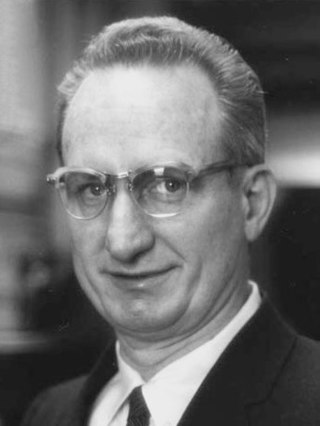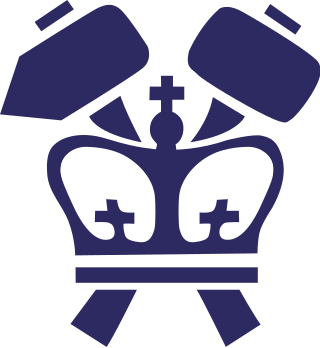
Henry Gwyn Jeffreys Moseley was an English physicist, whose contribution to the science of physics was the justification from physical laws of the previous empirical and chemical concept of the atomic number. This stemmed from his development of Moseley's law in X-ray spectra.

Theodore Harold Maiman was an American engineer and physicist who is widely credited with the invention of the laser. Maiman's laser led to the subsequent development of many other types of lasers. The laser was successfully fired on May 16, 1960. In a July 7, 1960, press conference in Manhattan, Maiman and his employer, Hughes Aircraft Company, announced the laser to the world. Maiman was granted a patent for his invention, and he received many awards and honors for his work. His experiences in developing the first laser and subsequent related events are recounted in his book, The Laser Odyssey, later being republished in 2018 under a new title, The Laser Inventor: Memoirs of Theodore H. Maiman.

Clyde Lorrain Cowan Jr was an American physicist and the co-discoverer of the neutrino along with Frederick Reines. The discovery was made in 1956 in the neutrino experiment. Reines received the Nobel Prize in Physics in 1995.

Leo James Rainwater was an American physicist who shared the Nobel Prize in Physics in 1975 for his part in determining the asymmetrical shapes of certain atomic nuclei.

Arthur Holly Compton was an American physicist who shared the 1927 Nobel Prize in Physics with C. T. R. Wilson for his discovery of the Compton effect, which demonstrated the particle nature of electromagnetic radiation. It was a sensational discovery at the time: the wave nature of light had been well-demonstrated, but the idea that light had both wave and particle properties was not easily accepted. He is also known for his leadership over the Metallurgical Laboratory at the University of Chicago during the Manhattan Project, and served as chancellor of Washington University in St. Louis from 1945 to 1953.

The Fu Foundation School of Engineering and Applied Science is the engineering and applied science school of Columbia University, a private research university in New York City. It was founded as the School of Mines in 1863 and then the School of Mines, Engineering and Chemistry before becoming the School of Engineering and Applied Science. On October 1, 1997, the school was renamed in honor of Chinese businessman Z.Y. Fu, who had donated $26 million to the school.

Katharine Burr Blodgett was an American physicist and chemist known for her work on surface chemistry, in particular her invention of "invisible" or nonreflective glass while working at General Electric. She was the first woman to be awarded a PhD in physics from the University of Cambridge, in 1926.

Arthur Jeffrey Dempster was a Canadian-American physicist best known for his work in mass spectrometry and his discovery in 1935 of the uranium isotope 235U.

William David Coolidge was an American physicist and engineer, who made major contributions to X-ray machines. He was the director of the General Electric Research Laboratory and a vice-president of the corporation. He was also famous for the development of "ductile tungsten", which is important for the incandescent light bulb.

George Robert Carruthers was an American space physicist and engineer. Carruthers perfected a compact and very powerful ultraviolet camera/spectrograph for NASA to use when it launched Apollo 16 in 1972. Carruthers was inducted into the National Inventors Hall of Fame in 2003, and in 2011 he was awarded the National Medal for Technology and Invention.

Samuel King Allison was an American physicist, most notable for his role in the Manhattan Project, for which he was awarded the Medal for Merit. A professor who studied X-rays, he was director of the Metallurgical Laboratory from 1943 until 1944, and later worked at the Los Alamos Laboratory — where he "rode herd" on the final stages of the project as part of the "Cowpuncher Committee", and read the countdown for the detonation of the Trinity nuclear test. After the war, he returned to the University of Chicago to direct the Institute for Nuclear Studies and was involved in the "scientists' movement", lobbying for civilian control of nuclear weapons.
Albert Vinicio Báez was a Mexican-American physicist and the father of singers Joan Baez and Mimi Fariña, and an uncle of John C. Baez. He made important contributions to the early development of X-ray microscopes, X-ray optics, and later X-ray telescopes.

Otis Frank Boykin was an American inventor and engineer. His inventions include electrical resistors used in computing, missile guidance, and pacemakers.
Rangaswamy Srinivasan is a physical chemist and inventor with a 30-year career at IBM Research. He has developed techniques for ablative photodecomposition and used them to contribute to the development of LASIK eye surgery.

The death ray or death beam was a theoretical particle beam or electromagnetic weapon first theorized around the 1920s and 1930s. Around that time, notable inventors such as Guglielmo Marconi, Nikola Tesla, Harry Grindell Matthews, Edwin R. Scott, Erich Graichen and others claimed to have invented it independently. In 1957, the National Inventors Council was still issuing lists of needed military inventions that included a death ray.

Hakeem Muata Oluseyi is an American astrophysicist, cosmologist, inventor, educator, science communicator, author, actor, veteran, and humanitarian.














